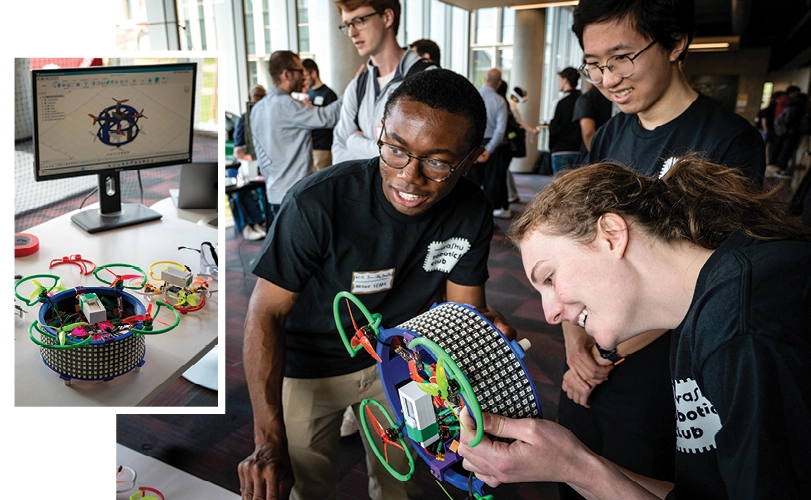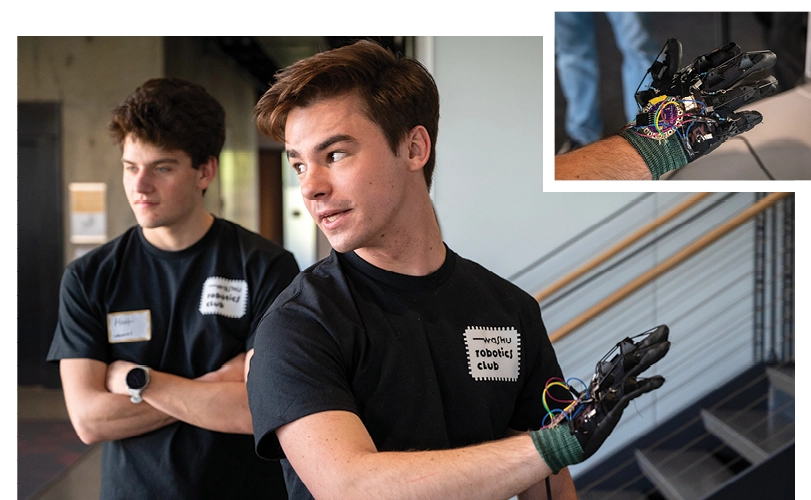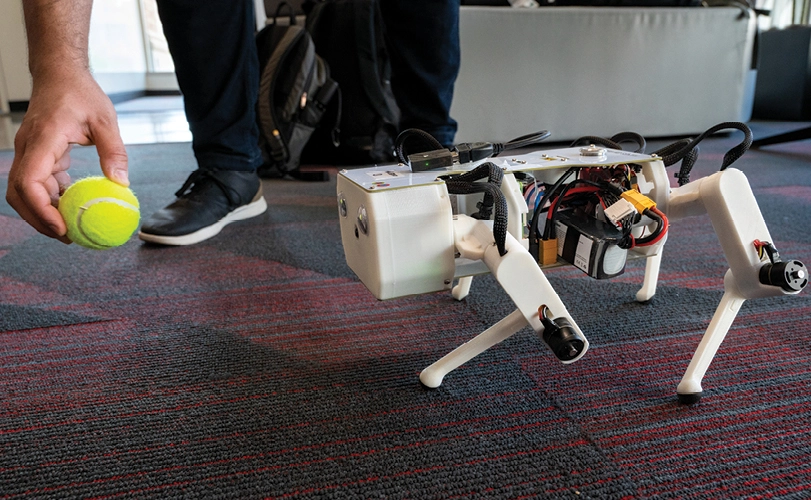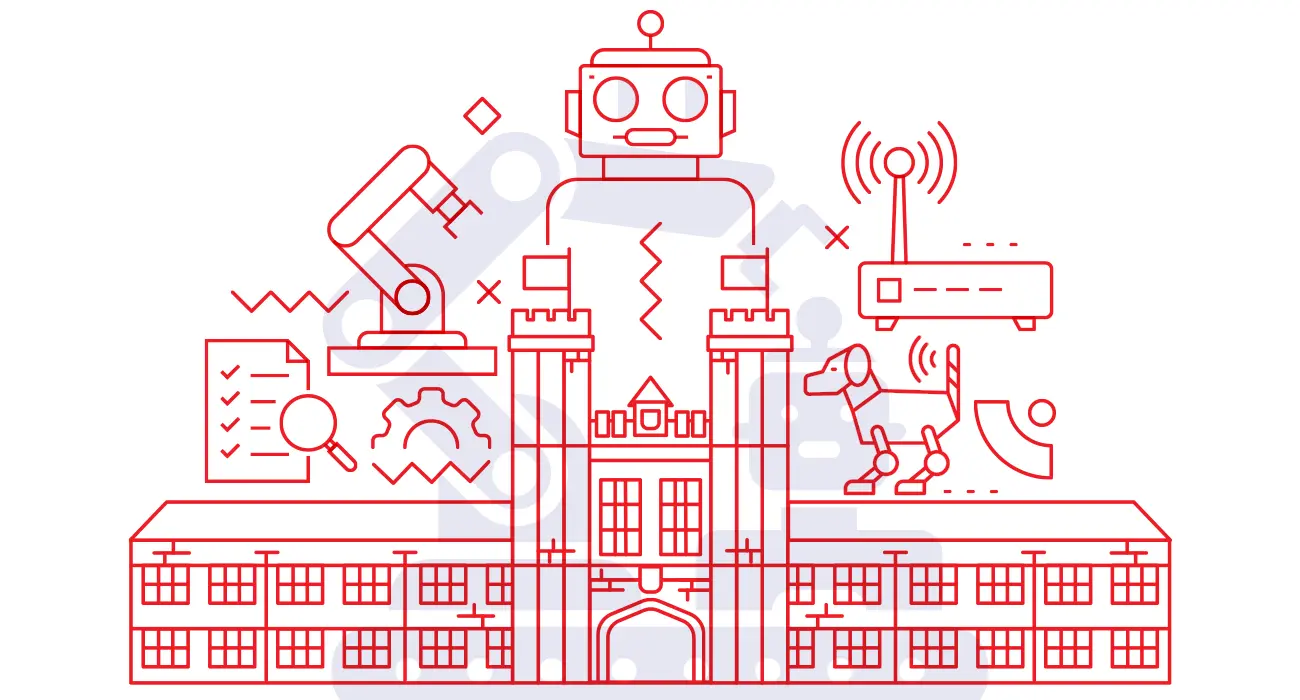Engineering the future: The rise of WashU Robotics
WashU Robotics Club founders Liana Tilton and Jack Nanez reflect on the community they’ve built in just under two years and look ahead to what’s next
Every Saturday, in the basement of James M. McKelvey, Sr. Hall, an eclectic group of innovative students gather, drawn together by their shared love of robotics. Meetings of the WashU Robotics Club buzz with activity, alive with the challenges of hands-on problem solving and the thrills of effort rewarded.
Since its founding in January 2022, the club has grown from 13 members with three robots to 270 total members, with 60 active members working on six complex projects, including a robotic dog, flying drone, virtual reality/augmented reality headset, robotic arm, flexible wearables, and PacBot navigator. Founding president Liana Tilton and vice president Jack Nanez lead an expanded 11-member executive board with the support of faculty adviser Yiannis Kantaros, assistant professor of electrical & systems engineering, and mentor Louis Woodhams, senior lecturer of mechanical engineering & materials science.

Joshua Cheng and Kathleen Weng (right) describe the autonomous PacBot robot they designed to navigate a physical Pac-Man field. WashU Robotics earned an honorable mention at the Harvard PacBot competition last spring.
“When we founded WashU Robotics, we wanted the club to be different from other engineering design clubs,” said Tilton, a senior majoring in electrical engineering with a minor in robotics. “Instead of focusing on one project per year or choosing a competition team in the fall, we have multiple projects going on year-round.”
WashU Robotics’ open door requires a careful balance of introductory opportunities for newcomers alongside competitive projects that can go head-to-head with more established robotics teams. And their efforts are already paying off. WashU Robotics earned an honorable mention at the Harvard PacBot competition last spring against engineering teams from MIT and Princeton University in the task of having a from-scratch autonomous robot navigate a physical Pac-Man field.

Membership also continues to rise, infusing a remarkable diversity of talent into WashU Robotics. The club includes students from all undergraduate schools at WashU, all majors in the McKelvey School of Engineering and all levels, from first-year to doctoral students.
“No matter how much we grow, we always want to consider our accessibility,” said Nanez, a senior majoring in mechanical engineering. “Whatever experience you have in robotics, there’s always more to learn, so lots of teaching happens at club meetings. Older members help new members; teams lend support to other teams, helping with tools, designing and coding.
The club's rapid growth is a testament to the unwavering interest and enthusiasm for robotics at WashU.”
— YIANNIS KANTAROS
Faculty Adviser
“We don’t want to lose that dynamic — those interactions that make the club and the community so fun — even as we look ahead to doing more big competitions,” Nanez added.
The club’s focus on building community as much as crafting cool robots is baked into its foundation. A fortuitous pairing in circuits lab connected Tilton and Nanez, who quickly discovered a shared interest in robotics. Tilton said her participation in the FIRST Robotics Competition in elementary and high school, combined with her growing interest in robotics research, is what drew her to McKelvey Engineering. However, when she arrived at WashU, Tilton was shocked to discover there was no robotics club. Like any respectable WashU engineer, Tilton identified this problem and set out to solve it.
“I’ve always had an interest in entrepreneurship and a desire to try and start something,” Tilton recalled. “After talking with Jack and others in my classes who also loved doing robotics in high school, I believed we could build something special. And McKelvey gave me that opportunity to create something new.”
Nanez said forming the club was about more than the technical side of robotics.
“The community aspect of having people who are interested in the same things is what makes the club so awesome,” he said. “Pulling late nights working on robots or hanging out on the weekend finishing a project together have been some of my favorite experiences at WashU.”

(From left) Matthew Giardinelli and Daniel Melka explain the glove.
As WashU Robotics continues to grow, with funding from the National Havoc Robot League and McKelvey Engineering, more opportunities for club members to do what they love are on the horizon. The team’s very first robot, Pupper, an adorable robotic dog, has gotten an AI upgrade and is learning to fetch and perform other tasks. A beefier, smarter robotic arm is in the works to enable the team to participate in more competitions and give members hands-on experience with technology that will be critical in next-generation surgical applications. And Flashbird, a flying, flashing drone the team built from scratch, will soon be equipped with more bells, whistles and ways to say “Hello, WashU!” in flight.
“I am continually amazed by the remarkable leadership skills demonstrated by club members and their unwavering passion for innovation and collaboration,” Kantaros said. “This is evidenced by the rapid progress they achieve in their collaborative projects, the external funding they secure, their established connections with the industry, and their exceptional capacity to inspire and motivate their peers.
“The club's rapid growth is a testament to the unwavering interest and enthusiasm for robotics at WashU,” Kantaros added. “It is a privilege to witness this incredible journey, and I eagerly look forward to further empowering the club's members and supporting their aspirations.”

Pupper, the robotic dog, is learning how to fetch and perform other tasks.

